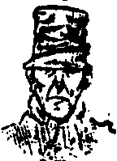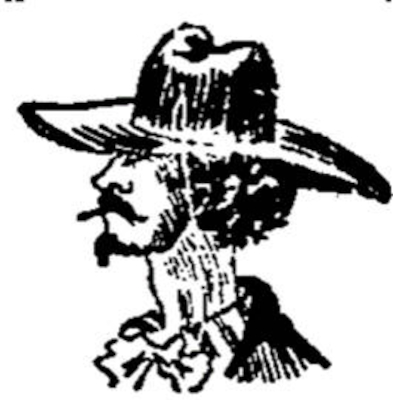This article has been transcribed from a copy of the Cardiff Times in the online collection of scanned Welsh newspapers 1804-1919 in the National Library of Wales, with grateful recognition of the free access accorded to all readers. Paragraph breaks have been introduced for easier reading.
It is ironic that an article dealing with visual representation should have only three illustrations to the four or five of the preceding articles. In no. 95, one of the images is almost certainly misplaced. It shows a strangely proportioned, seated figure, resulting from, the caption would have us believe, faulty focus in a photograph. That article doesnt mention photography, and carelessness in the sorting of images is probably to blame. Perhaps the writer has little say in the process. Samuel has little understanding of photography, distrusting it as recent innovation, lower down the accepted scale of artistic quality than fresco, oil painting, watercolour or drawing (in that descending order). He prefers to use photographic prints instead of cardboard to safely pack drawings to be sent by post. He is, however, probably right to distrust many promotional photographs. Morally as well as aesthetically dubious subjects, such as Miss Legpegs, Premiere Danseuse, Miss Tottie Rorty, the ‘charming comedienne[’]; Miss Fitzgush Florence, of the chorus, are favourites with collectors. The wish to resemble a celebrity which is spelt out in the caption to the first illustration is morally as well as factually dubious by the standards of the day, Lilly Langtry (née Le Breton; 1853-1929), being mistress to the Prince of Wales, later Edward VII. —— David Skilton

A photographic fright fancies herself more beautiful that Mrs Langtry all the same.
HE fact is, every body is photographed nowadays, sir, in some way or another, and I can well account for this fact of course. Vanity is at the bottom of it all. Photography may well be popular. A man wants to see what he looks like, so he goes and pulls his face into an expression that is neither human nor divine, and he looks at the result and is very seldom satisfied. He doesn't think that the picture is good-looking enough as a general rule. When he shows his friends the picture he deprecatingly asks, ‘Do you know who this is?’ and if it is very flattering, his friends are expected to say, ‘Oh, of course, and how very like you.’ If it is not flattering his friends say that they don't think the photo has done the subject justice, and all parties are more or less on good terms about the matter. As a general rule a man says, when you have examined his portrait and given vent to the necessary comments, But don't you think that there is something wrong about the hair (or the nose, or the eyes, or the smile, or whatever you like; it doesn't matter a bit). Then comes the time for unadulterated lying on the part of the inspector of the portrait. ‘Now I come to examine it,’ he says, after affecting to examine it with painful intentness, ‘I really think there is: it is a good photo, as a photo, though’ (excellent expression this, really — just try it); ‘but I don't think much of it as a likeness.’ A very little man always likes to have his head and shoulders alone taken, and this on a big scale, too, for he can imagine himself about seven feet high at the very least by doing so, so nobly do his chest and shoulders come out, and when he sends the picture to friends or relations in a distant part who have never seen the original he can indulge in such pleasant thoughts as to what a fine fellow they will think him. Bless your life, photographs seldom give a true idea of a man, for his vanity will not allow the photographer to bring out his weak points along with his strong ones, and the vanity of the photographer himself will not allow the sitter to exercise his own wise discretion. Mind you, I am not blaming the photographer not a bit. He could hardly, when a man with cocoa-nut knees, that cling affectionately together, goes in to him, he can scarcely say, In order that I may give you a really truthful picture of you that will be recognised by your friends, I must ask you to let me include your legs. He could hardly do that, could he, sir, that is without giving some little just a little, you know offence? Thus it is that when a man is b[a]ld, he usually elects to be taken with his hat on; when he has a goodly nose that he imagines bears a resemblance to that of the Duke of Wellington, deceased, he prefers to be taken in profile; when he has a wart or two on the left side of his face he has the right side photo'ed; when he has no teeth he keeps his mouth shut, and when he thinks he has very good ones, he grins with the cast-iron grin of a septuagenarian ballet girl. All this shows how much photographs are to be relied upon as faithful transcripts of nature where men are concerned.

This not a genuine tramp choosing to be photoed. A popular low comedian with a property suit of rags.
affects to be anxious to obtain my photograph. I smell flattery, and I know as well as anybody does that one class of people only ask for photos because they have got a new album, and want to fill the greater portion of the spaces as soon as possible, like a newspaper canvasser. Others there are who get one's portrait and then, when they think that one will not be in evidence near their domiciles for some time, write derogatory and insulting comments on the picture. The reason I do not care to entrust my counterfeit presentment to lady applicants is so obvious that I need not here dwell upon the matter. I only need say that Mrs Samuel has a habit of making unpleasant comments touching forward hussies and artful minxes. On the other hand I am not too grateful when other people insist on pressing their features on me. Actors and actresses love to do this generally in the hope of getting a picture done in some newspaper. They seem literally to burst over with photographs; but whether they pay for them or no I am unable to say. It they do, the photos are about the only things they do pay for. I have hundreds of portraits of such celebrities as Miss Legpegs, Premiere Danseuse, Miss Tottie Rorty, the ‘charming comedienne[’]; Miss Fitzgush Florence, of the chorus, and others in the same walk of life given to me by the originals, and I have been duly flattered, and (heaven forgive the hypocrisy) flattering in my remarks concerning them, though, to confess the truth, I have afterwards either given them to some young bachelor friend who wanted to decorate his room with them or utilised them instead of cardboard to safely pack drawings to be sent by post. Fact is, sir, there is something mentally meretricious about the portraits of young female persons on the stage; there is generally very much too much of such persons, and, although I do not hold that the British matron should entirely control the ornamentation of one's rooms I yet think that ordinary burlesque undress is out of place in a family man's portrait album. I read the other day that a certain well-known purveyor of dramatic photographs was interviewed and stated that he sold enormous quantities of such-like things. Well, all that I can say is that fools and their money are soon parted. All these dramatic portraits are ‘faked’ up almost as much as the original herself is prior to submitting herself to the ‘artist,’ and as for the portraits of the shaven dramatic men, anyone can see vanity and outrageous conceit in every line of them. Authors and artists do not commonly seek this method of advertisement at the hands of foolish young women, though the actor who has just left the draper's shop generally does.

The photographic artist fancies himself an artist, too.
There are certain photos, sir, which are unlucky. For instance, it is very unlucky indeed to be taken in conjunction with a girl — because you may take it into your head to get another girl, and then if she sees that photo there are ructions, and not a few. The young man, too, is very silly who when he has a holiday and indulges in a little spree with a friend or two has his photo taken with them and displays his inebriety by the hat cocked on one side, the vacuity of countenance, the long clay pipe, and the half spilt glass usual in such pictures. His employer may see it and then up will go the merry little notice. Photos, sir, are no indications whatever of the characters of men and women. A friend of mine once said to me that if he saw a man's album be could tell pretty well the sort, of society that man mixed in. But this is all gammon, sir. Snobbish people fill their albums with show photos and eliminate the old-fashioned presentments of their poor relatives.
Links to Related Material
Last modified 10 March 2022